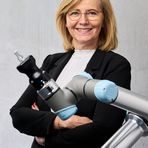How technology and automation can help manufacturers attract and retain workers – and why HR leaders must lead the charge.
This is why HR teams should care about robotics
I grew up among large production machines. My father was managing a large brewery in Denmark, and throughout my childhood I witnessed firsthand how the employees had to perform hard manual labor which took a toll on their bodies.
The risk of getting injured was always there, and I experienced how robots, when they began to be introduced, created a more productive workplace with better conditions, higher safety, and greater possibilities for growth.
Today, robot automation is at an entirely different level with the technology continuing to develop at an amazing pace. Especially at large manufacturing companies, automation is now widespread and an integral part of the production setup. But for many HR professionals, robotics is still new territory and surrounded by some mystery and even prejudice. This is a shame, as there are many ways robots can help companies to create a better workplace and to keep and attract talent.
As HR professionals we need to take notice of this technology because labor and skills gaps are a massive challenge for most of us and robotics can help provide a solution.
Let your people grow
Most HR teams are aware that robot automation can help supplement your workforce, and it is well documented that better productivity can be achieved by adopting automation, while also providing high and uniform product quality. Most also know that robots are ideal to handle those tasks no one really want to – or should – do. At Universal Robots we often refer to these as the 3Ds – the dull, dirty and dangerous tasks – and by automating these you can increase worker safety and reduce physical injuries.
But investing in technology is also a key part in being seen as an attractive workplace. Investing in technology not only enhances worker development but also boosts a company's appeal as an employer. This is especially true for younger workers, many of whom need persuading that manufacturing jobs are safe, fulfilling, and rich in opportunities for professional development and advancement.
Adopting strategies like cross-training, offering development programs, and career planning, coupled with updating technology and machinery, can enrich employee skills. The integration of technology, automation, and digitalization in manufacturing makes jobs more engaging and mentally stimulating. Keeping production updated with new technology, as well as encouraging employees to familiarize themselves with these technologies and trends, is a great way to remain an attractive workplace.

The (decreasing) workforce of the future
Manufacturers all over the world are facing serious issues with attracting skilled labour. US manufacturing is expected to have 2.1 million unfilled jobs in 2030. More than 80 percent of Chinese manufacturers faced labor shortages last year, and in Japan, Korea and Western Europe, demographic developments will mean a massive shortage of workers. In all these countries, the labor shortage is both real and deepening.
At the same time, our workforce is aging so finding ways to attract and retain senior workers, with all their important knowledge and expertise, is critical.
To effectively engage tenured workers, it's useful to offer and highlight continuous skill development and training opportunities. This keeps them updated with industry trends and technologies, fostering motivation, and leveraging their vast experience for company growth. At the same time, adapting the workplace to accommodate age-related physical needs by reducing strenuous tasks, for example by deploying collaborative robots, will also ensure a supportive environment, and enhance older workers’ contribution. An example of this is French company, Carbody, where a molder affected by years of hard work was able to retain his job as it was made easier by cobots handling the strenuous tasks. And at our own Universal Robots production site in Odense, Denmark, our cobots are already an integral part of production and the everyday life of my colleagues.
In short, while robots on the factory floor might not seem relevant to HR professionals, they absolutely are. Robots provide great opportunities for businesses to not only raise productivity and quality, but also to create safer, more fulfilling, and better workplaces for their employees.
So my message to fellow HR leaders is this: Embrace the new technologies for strategic workforce planning. The future of work demands innovation, and it’s our job to lead the charge.

- Universal Robots USA, Inc
- 27175 Haggerty Road, Suite 160
- 48377 Novi, MI